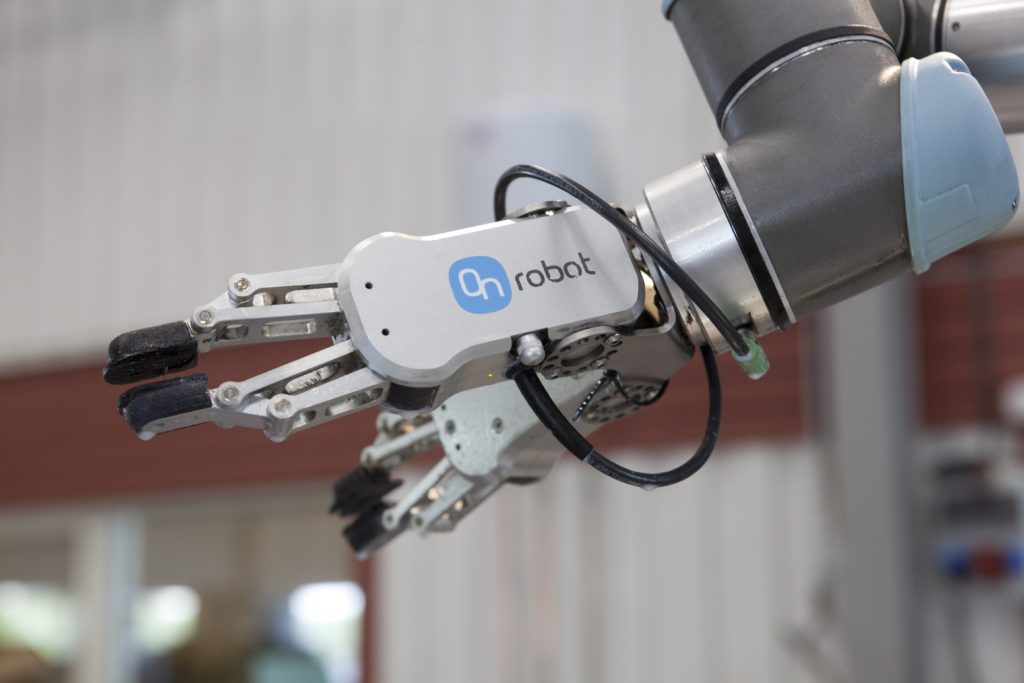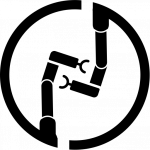
The new RG2-FT EOAT is an intelligent gripper that can see and feel objects using built-in force/torque sensing. Source: OnRobot
Smarter and more versatile end-of-arm tooling, or EOAT — sensors, grippers, and quick changers — empower robots to take over repetitive tasks. This can free them to handle adaptive, higher-precision, and more intelligent applications that in the past were too complex to automate.
More importantly, these advanced tools enable collaborative applications that allow human workers and robots to operate safely side by side due to the user-friendly nature, intuitive programming, and safety features of EOAT-fitted robots.
These innovations have helped significantly increase EOAT adoption. According to QYResearch, the global robotics EOAT market, valued at $1.58 million in 2018, is expected to reach $2.74 million by the end of 2025, growing at a compound annual growth rate of (CAGR) of 7.1% from 2019-2025.
Since each production facility varies in terms of the tasks to be automated, product shape and size, and materials and robots, manufacturers must find the tools that best suit their unique needs.
Prioritizing EOAT before the robot
Due to technological advances, EOAT has become more sophisticated and proficient. Now, how robots are deployed and what accessories are fitted and used will become more integrated than robots alone.
In the past five years, robots have been used in a wider range of applications than ever before because end effectors can now function better in more environments. Apart from handling variations in product size, weight, and shape, EOAT also enables robots to accommodate several processes at once. With the EOAT trend expanding across manufacturing, these enhanced capabilities mean that robot arms will soon be commodities. The kind of robot used won’t matter as much as the EOAT for the job.
And with more players entering the market, manufacturers need to focus on “more tools, more applications,” rather than “more robots, more applications.”
EOAT is expanding the breadth of industrial applications in which collaborative robots, or cobots, can be used by making them smarter, more reactive, and independent. This helps manufacturers meet a range of production goals. Production can be more flexible and more responsive to the speed of innovation and market changes, thereby fulfilling customer needs. Manufacturers are realizing they need to focus on the style of tooling that best suits the needs of a particular application before deploying robots.
Editor’s note: For more on cobots and grippers, see last month’s issue of The Robot Report.
Evolution of EOAT
Various tools help manufacturers meet their overall production goals. For instance, certain grippers can pick up products of differing sizes and materials. This enables applications such as machine tending, pick and place, packaging and palletizing, and assembly.
These days, most grippers are easily installed, with more flexible production and less downtime, which gives companies a more cost-effective solution that can handle large process variations.
Seconds count in the manufacturing industry. For Copenhagen, Denmark-based gear manufacturing company Osvald Jensen, cobots have been the solution to speeding up work and improving the machine shop’s performance and productivity.
The company uses cobots with dual RG2 collaborative grippers from OnRobot to load and unload its CNC machines. Where the single gripper performs the task in 27 seconds, the dual gripper finishes after a mere 15 seconds – winning the company 12 seconds on every cycle. By simply retrofitting the gripper, Osvald Jensen has increased productivity on its CNC machines significantly in a very cost-effective way.
The RG2-FT, the world’s first intelligent gripper, is another innovative tool to help manufacturers. It can see and feel objects using built-in force torque sensing.
Apart from its straightforward installation and program, the RG2-FT can detect the workpiece location even if it’s not precisely positioned. This increases production efficiency, reduces the risk of damages to the product, and offers greater precision in handling, making the application safer for workers, as well as the workplace.
Improving ROI
The ability of cobots to handle a growing range of industrial tasks thanks to EOAT can lead to faster returns on investment (ROI) for manufacturers. Thanks to their flexibility and ease of use, they can seamlessly switch between multiple tasks with minimal need for additional programming or tool swapping.
The robotic tools also notably increase productivity since they can operate around the clock, completing tasks with greater precision and reliability than human operators would.
In addition, safer collaborative robots and smart EOAT can reduce the cost of automation because workers can interact with them without needing safety fencing, complex programming, or lengthy installation.
The future is collaborative applications
With the dawn of smarter, more adaptive tooling, robots can now function with greater speed, strength, safety and precision, accomplishing a broader range of tasks and helping manufacturers maximize ROI.

Kristian Hulgard, OnRobot
About the author:
Kristian Hulgard is general manager for the Americas at OnRobot.
The post End of arm tooling: The secret sauce of collaborative applications appeared first on The Robot Report.

